
Fr: Albatros de Laysan
All : Laysanalbatros
Esp : Albatros de Laysan
Ital : Albatro di Laysan
Nd: Laysanalbatros
Sd: Laysanalbatross
Photographers:
Tom Grey
Tom Grey's Bird Pictures
Otto Plantema
Trips around the world
Text by Nicole Bouglouan
Sources:
HANDBOOK OF THE BIRDS OF THE WORLD vol 1 by Josep del Hoyo-Andrew Elliot-Jordi Sargatal - Lynx Edicions - ISBN: 8487334105
BirdLife International (BirdLife International)
Bird Web (Seattle Audubon Society)
What Bird-The ultimate Bird Guide (Mitchell Waite)
Wikipedia, the free encyclopaedia
Laysan Albatross
Phoebastria immutabilis
Procellariiforme Order – Diomedeidae Family
INTRODUCTION:
Although the Laysan Albatross is a species of the Northern Hemisphere, its breeding habits are those of a bird of the Southern hemisphere. Actually, it breeds during the local winter which corresponds to the austral summer, suggesting that this species originated in the S Hemisphere. It has probably spread northwards centuries ago, into the Northern Pacific where it is now resident.
Albatrosses are long-lived birds, and the Laysan Albatross may reach 40 years and more.
DESCRIPTION OF THE BIRD:
Biometrics:
Length: 79-81 cm
Wingspan: 195-203 cm
Weight: 2300-3200 g
The adult has blackish-grey upperparts whereas head, lower rump and underparts are white. The underwing pattern may vary between birds which show narrow black margins and variable amounts of black on the underwing-coverts.
On the white head, a grey patch extends from chin to cheeks and ear-coverts. It can be sometimes indistinct from distance, except around the eye where the colour becomes almost black.
The typical bill is pink with grey tip on both mandibles, and the upper one has hooked tip. The eyes are dark brown, with pale grey eyering, mostly white below. Legs and webbed feet are pale pinkish-grey.


Male and female have similar appearance, but the male is larger than the female.
The juvenile resembles adults and has dark upper rump.
The chick has thick, long dark brown down. The eyes are very dark. The bill is dark grey. Lores and eyering are pale grey. Legs and feet are brownish. But at hatching, the down is mostly greyish.
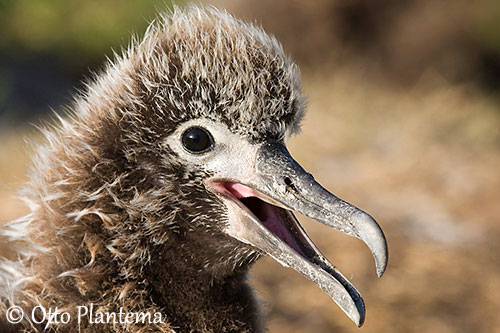
RANGE:
The Laysan Albatross breeds in NW Hawaiian Archipelago, but mainly on Laysan and Midway Islands. It also breeds off Baja California, and a more recent colony is established on Bonin Islands, off SE Japan.
During the non-breeding season, this species is living out at sea in N Pacific Ocean, as far North as Bering Sea, and E to the Pacific coast of North America.
They are more numerous on the west side of N Pacific, and other populations are found in Canada, Japan, Mexico and Norfolk Island in the Pacific Ocean.
HABITAT:
The Laysan Albatross is marine and pelagic, usually out at sea except during the breeding season. It breeds on bare oceanic islands, sometimes with low vegetation, in open sandy or grassy areas. However, it usually prefers flat grounds with some vegetal cover and protection from the wind.

CALLS AND SONGS: SOUNDS BY XENO-CANTO
The Laysan Albatross is usually silent at sea, but it may utter some croaking or gargling sounds when following the fishing boats for offal, that is less frequent than in other species.
On land, a typical rattling sound produced by clappering the bill quickly and repeatedly, is usually used during courtship displays. We can also hear throaty cries, grunts and moans. These sounds can be also used as a threat against intruders.
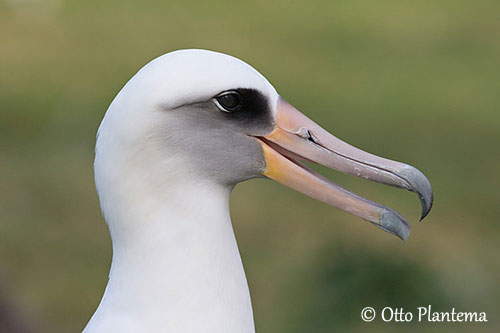
BEHAVIOUR IN THE WILD:
The Laysan Albatross feeds on aquatic preys such as squid, fish, crustaceans, and invertebrates such as coelenterates. The squid is taken during the night, when it is close to the surface.
The Laysan Albatross feeds at water surface and catches its preys from just under the surface.

This species mates for life. They are sexually mature at 6-7 years old.
They come to land for breeding. Courtship displays are complex and the repertoire is ample. They perform long sequences of stereotyped postures, usually repeated over and over again. Several displays are reported including bill-circling, sky-pointing, and flank-touching with the bill. The full spreading wing display is accompanied by calls while mates are facing each other.
Such displays can be performed even at sea and not necessarily in the territory.

The pairs formed since several years do not need elaborate displays. They meet at the usual nest-site where the male arrives a few days before the female. They perform greeting ceremonies.
The nest-site is defended by both adults, mainly at the beginning of the breeding cycle. Bill-clapping towards intruders and short but violent fights may occur.
They breed in colonies and this species may form large aggregations.

Like all albatrosses, the Laysan Albatross is a good flier, but rapid manoeuvres are not easy. In the same way, take-off needs some running while performing wingbeats, and landing is often hazardous due to the short tail which does not allow many manoeuvres. Crash-land on its side, and turn head over heels can be common.

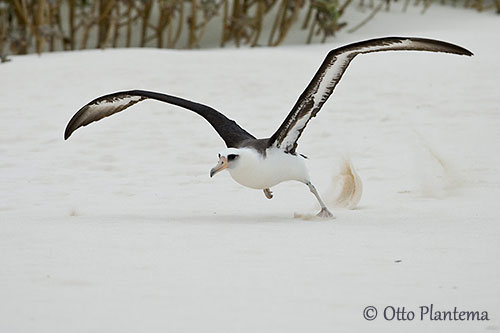
In order to allow easier movements, some colonies have runways free from nests where the birds can take-off and land.
But once in the air, the Laysan Albatross glides along on stiff wings, rising and falling alternately according to the wind.
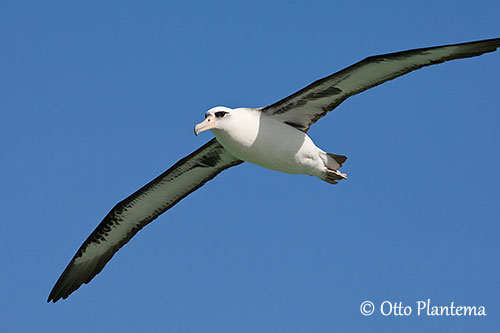
REPRODUCTION OF THIS SPECIES:
The breeding season starts in November.
The Laysan Albatross breeds in colonies, sometimes large ones, and often in company of the Black-footed Albatross (P. nigriceps).
The nest is built by both adults. This is a shallow depression in the sand. Some debris mixed with sand can form a substantial rim.
The female lays a single whitish egg with brown spots. Both parents share the incubation during 65 days, with stints of 3 weeks. The downy chick is fed by regurgitation of squid oil and flying-fish eggs. Both adults hunt for food and leave the chick alone for several days. It fledges about 165 days after hatching.
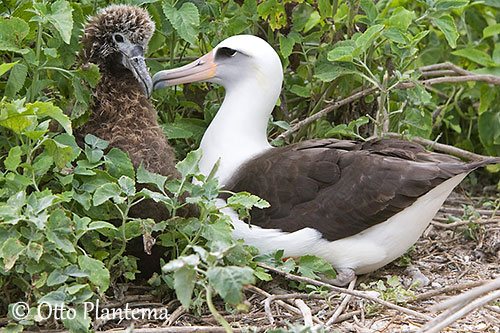
Usually, numerous young birds die during their first year. Once the chick leaves the nest and goes out at sea, it does not return to land for 3-5 years. It returns to its nesting colony where it searches for a mate, through elaborate displays.
PROTECTION / THREATS / STATUS:
The Laysan Albatross suffered large declines in the late 1800s, with feather and egg collecting. But populations have recovered until these practices have been banned in 1909.
Man-related mortality at sea, predation by rats, cats and dogs, plastic ingestion, lead poisoning and human disturbances are the main threats for this species which is currently evaluated as Near Threatened.